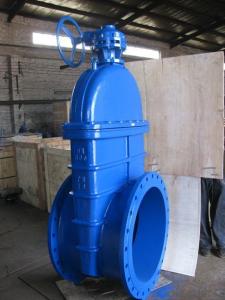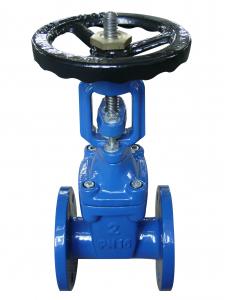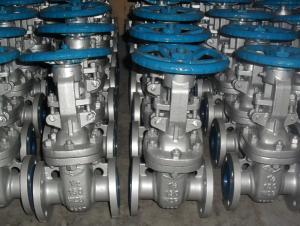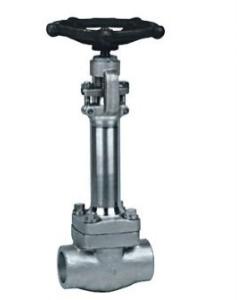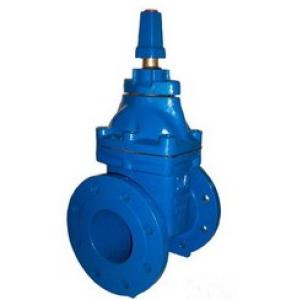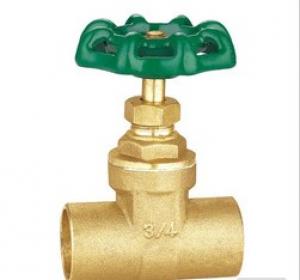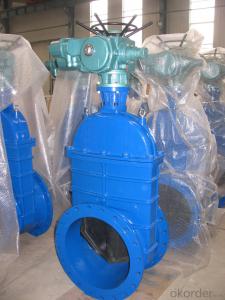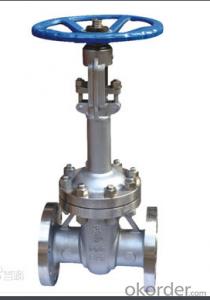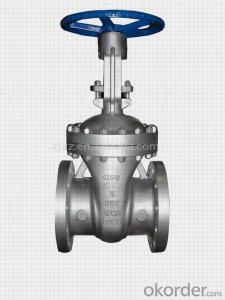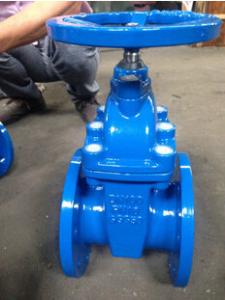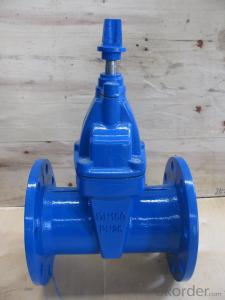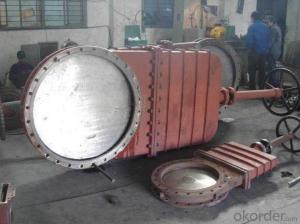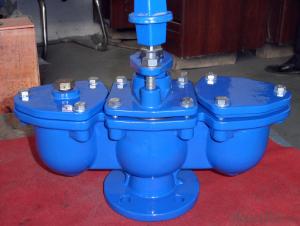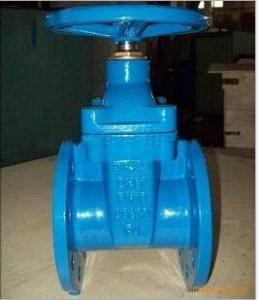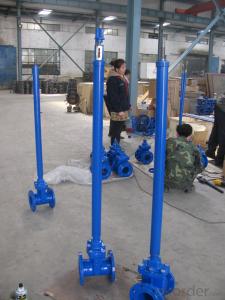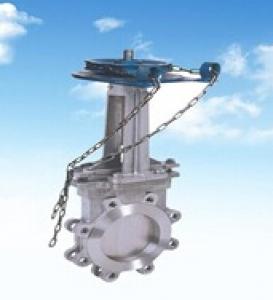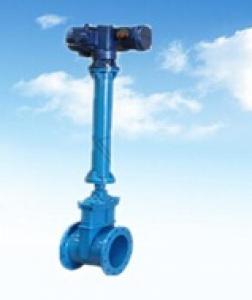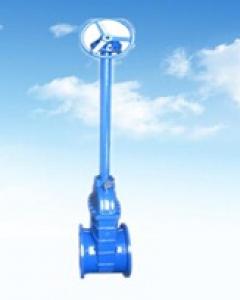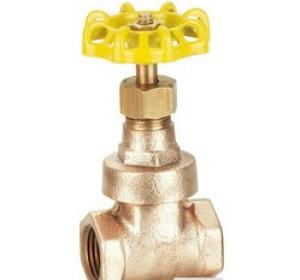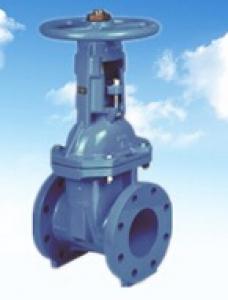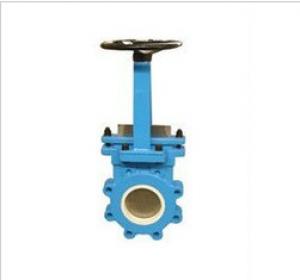Ductile Iron Gate Valves
- Loading Port:
- China main port
- Payment Terms:
- TT OR LC
- Min Order Qty:
- 100 pc
- Supply Capability:
- 1000 pc/month
OKorder Service Pledge
OKorder Financial Service
You Might Also Like
1.Structure of Gate Valve Description:
A gate valve, also known as a sluice valve, is a valve that opens by lifting a round or rectangular gate/wedge out of the path of the fluid. The distinct feature of a gate valve is the sealing surfaces between the gate and seats are planar, so gate valves are often used when a straight-line flow of fluid and minimum restriction is desired. The gate faces can form a wedge shape or they can be parallel. Gate valves are primarily used to permit or prevent the flow of liquids, but typical gate valves shouldn't be used for regulating flow, unless they are specifically designed for that purpose. Because of their ability to cut through liquids, gate valves are often used in the petroleum industry. For extremely thick fluids, a specialty valve often known as a knife valve is used to cut through the liquid. On opening the gate valve, the flow path is enlarged in a highly nonlinear manner with respect to percent of opening. This means that flow rate does not change evenly with stem travel. Also, a partially open gate disk tends to vibrate from the fluid flow. Most of the flow change occurs near shutoff with a relatively high fluid velocity causing disk and seat wear and eventual leakage if used to regulate flow. Typical gate valves are designed to be fully opened or closed.When fully open, the typical gate valve has no obstruction in the flow path, resulting in very low friction loss.
2. Main Features of the Gate Valve:
• Valve body cavity using non-toxic epoxy resin,both inside and outside flashboard completely is coated with rubber
• Free of water pollution
• High manufacturing accuracy
• High strength
• Environmental protection and energy saving
• Good visual effect
3. Images
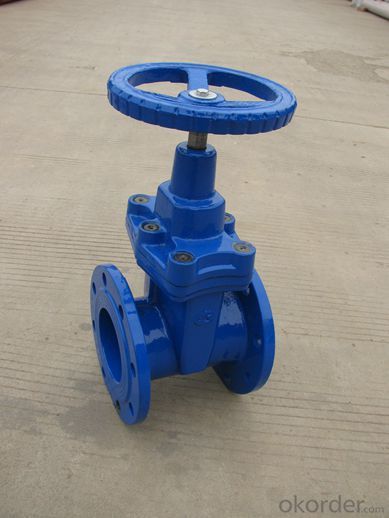
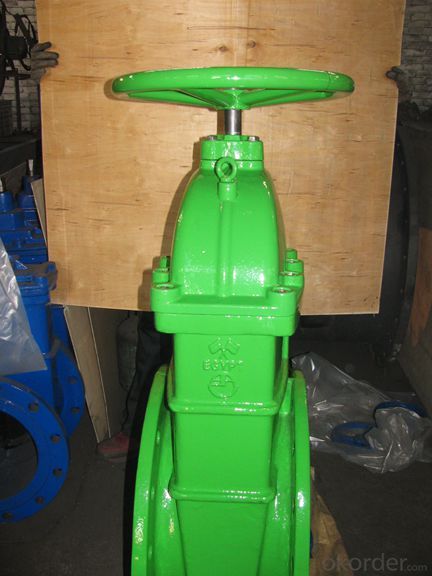
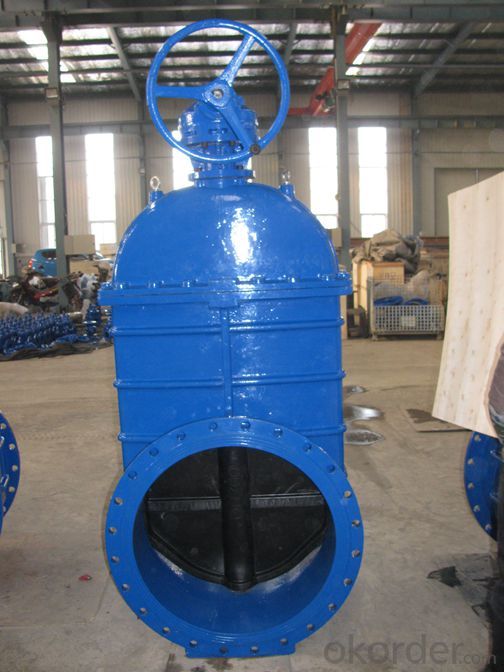
4. Gate valve Specification

5.FAQ
1. What's are the characteristics of gate valve?
The distinct feature of a gate valve is the sealing surfaces between the gate and seats are planar, so gate valves are often used when a straight-line flow of fluid and minimum restriction is desired. The gate faces can form a wedge shape or they can be parallel.
2. What is the work principle of gate valve ?
The gate faces can form a wedge shape or they can be parallel. Gate valves are primarily used to permit or prevent the flow of liquids, but typical gate valves shouldn't be used for regulating flow, unless they are specifically designed for that purpose. Because of their ability to cut through liquids, gate valves are often used in the petroleum industry.
3. What is the structure?
Bonnets provide leakproof closure for the valve body. Gate valves may have a screw-in, union, or bolted bonnet. Screw-in bonnet is the simplest, offering a durable, pressure-tight seal. Union bonnet is suitable for applications requiring frequent inspection and cleaning. It also gives the body added strength. Bolted bonnet is used for larger valves and higher pressure applications.
- Q: What are the advantages and disadvantages of flat gate valves?
- The disadvantage of flat gate valve is that when the medium pressure is low, the sealing force of the metal sealing surface is insufficient, so as to achieve satisfactory sealing. On the contrary, when the medium pressure is high, if the sealing surface is not lubricated by the system media or foreign media, often opening and closing may cause the sealing surface to wear too much. Another disadvantage is that the circular motion of the circular gate in the circular flow, only when it is at the valve closed position of 50%, this valve is more sensitive to flow control. Moreover, the gate will produce severe vibration when it breaks the high-speed and dense medium flow. The valve seat can also be throttled if the seat is made of a V - shaped opening and is tightly oriented to the gate.
- Q: What is the difference between the cut-off valve and gate valve, the general will use the cut-off valve instead of gate valve
- Stop valve and gate valveThe working principle is different. The stop valve is an upward stem type, and the handwheel rotates and rises with the stem. Valve is hand wheel rotation, stem upward movement. Flow is not the same, the gate valve requires full open, the cut-off valve is not the same. The gate valve has no inlet and outlet direction requirements, and the cut-off valve has the required inlet and outlet!Gate valve and stop valve are shut-off valve, is the most common two valves.From the exterior, the gate valve is shorter than the cut-off valve, especially the bar valve needs a higher height space. Valve sealing surface has a certain degree of self sealing capacity, its spool depends on the media pressure tight contact with the valve seat sealing surface, to achieve tight leakage. Wedge gate valve spool angle is generally 3~6 degrees, when forced to shut down excessive or temperature changes of the valve core is easy to die. Therefore, high temperature and high pressure wedge gate valve, in the structure have taken certain measures to prevent spool stuck. The valve in the opening and closing valve and valve seat sealing surface contact and mutual friction is always so easy to wear sealing surface, especially in close off the valve, the valve before and after the great pressure, sealing surface wear is more serious.
- Q: The difference between flanged gate valve and common gate valve
- General diameter of more than 50 with flanges, inspection wells, main pipes, trenches... Must use flange gate valve, good operation, good replacement.
- Q: Why is gate valve or butterfly valve used for water pump?
- General pressure is small, use the butterfly valve, when the pressure is big, use the gate valve. The two main function of the valve is to adjust the flow and easy to overhaul.Zibo Boshan new Duke water supply equipment
- Q: What is gate valve (with force transfer joint)?
- Flange valve is equipped with a force expansion joints, easy installation
- Q: What does Z941H-25DN250 mean by electric gate valve (excluding electric equipment)?
- Cast steel flanged gate valve 25 pressure bore 250
- Q: What is the difference between cut-off valve and gate valve?
- Simply put, the cut-off valve is one-way, only into, do not give up, the valve is two-way
- Q: Function of gate valve
- Gate valve is a closed (gate) along the central line of the vertical direction of the valve moving. Valve in the pipeline can only be fully open and fully closed off, can not be adjusted and the throttle. Gate valve is a valve used in a wide range, generally more than 50mm caliber DN block device is selected it, sometimes cut off very small aperture devices are used to gate valve, gate valve is used as cut-off media, when in full flow through the whole, when the media is running a minimal pressure loss. Gate valves are normally used in situations where they do not need to be frequently opened and closed, and the gate is fully open or fully closed. Not used as an adjustment or throttling. For high speed moving medium, the gate can cause the vibration of the gate under the condition of partial opening, and the vibration may damage the sealing surface of the gate and the valve seat, while throttling will cause the gate to suffer the erosion of medium.
- Q: What does gate valve DN80-PN16-QT450 mean?
- DN80 means: liquid, internal thread connection, the valve sealing surface material for rubber, seat sealing surface material for lining adhesive, nominal pressure of 10 kg / cm2, nominal diameter of 80mm Iron Butterfly valve.
- Q: What gate valve is the J41H-150LBDN100 gate valve?
- Its closing principle is to rely on the valve bar pressure, so that the valve sealing surface and seat sealing surface close together, to prevent the circulation of media. The cut-off valve is divided into three kinds: straight through type, right angle type and direct current type oblique stop valve.
Send your message to us
Ductile Iron Gate Valves
- Loading Port:
- China main port
- Payment Terms:
- TT OR LC
- Min Order Qty:
- 100 pc
- Supply Capability:
- 1000 pc/month
OKorder Service Pledge
OKorder Financial Service
Similar products
Hot products
Hot Searches
Related keywords
